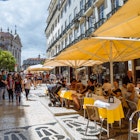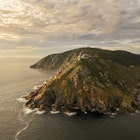
Portugal vs Spain: which Iberian dream is right for you?


Relax on a beach in Portugal’s Algarve, or check out one of Spain’s many Unesco sites, like Santiago de Compostela Cathedral? You decide. iStock
Iberia boasts an embarrassment of riches for visitors, making this corner of Europe one of the most popular spots in the world for tourism. A seemingly endless coastline, sun-drenched landscapes, rich and varied cultures and some of the best food you'll ever taste – it's no wonder we can't get enough.
But the downside of these riches is where do you even begin when it comes to what to see and do; several lifetimes later there will still be endless options. Before you get into the nitty gritty of cities and regions, let's start with the main question – Spain or Portugal?
Spain may have the square mileage but Portugal packs an almighty punch within its borders. To help you with this delicious quandary, we've enlisted two of our experienced writers who know and love these destinations better than anyone. Take it all in, ponder the arguments and make your choice about which Iberian dream is perfect for you.
Portugal approaches perfection
Travel writer and longtime Lonely Planet contributor Kerry Walker has hitchhiked with Thai royalty, served beer at Oktoberfest and swum with sharks in the course of her reporting. But it’s Portugal that she can’t seem to stop visiting again and again.
Spain has stolen Portugal’s thunder for years. But while its hot-blooded, fiesta-loving, fiery-tempered bigger sister has long bragged about its beauty, Portugal has always whispered quietly about its charms. Now it’s finally having its moment to shine.
My first Portuguese trip was to the west coast of the Algarve; as an unruly 11-year-old, I preferred clambering up honeycomb cliffs and rolling in the waves to flopping on the beach. I would find secret spots to gaze out across the booming Atlantic and dream of those great Age of Discovery navigators, setting sail for new worlds aboard storm-tossed caravels.

Little did I know then that these childhood trips would spark a life-long love affair with the country. I’ve now trotted across most of Portugal – from the surf-smashed, dune-rippled coast of the Costa Vicentina to the alley-woven medieval towns and menhirs of the Alentejo, the time-lost granite mountain villages of the Minho and the heaven-on-earth vineyards of the Douro. Trust me: beyond its big hitters, most of Portugal is spectacularly unsung.
Spain has its costas, but Portugal’s beaches are wilder still, with dunes and cliffs crashing down to vast scoops of butterscotch sand. And the surf! There’s nowhere better to feel the life-affirming slap of the Atlantic than at Ericeira, Peniche (the jump off-point for the gorgeous Ilhas Berlengas nature reserve, with its cluster of granite islands and turquoise coves) and Costa Vicentina treasures like Praia do Amado and Praia da Arrifana. Even on Lisbon’s doorstep, you’ll be blown away by Parque Natural da Arrábida, where thickly wooded hills fall away to pale sands and glassy seas where minke whales and dolphins frolic.
And there is real magic at Cabo de São Vicente. Arrive during a flaming sunset and you can well imagine that there is little but ocean between continental Europe’s southwesternmost point and the shores of America.

Spain’s sierras and river-woven valleys get all the fuss, but Portugal is every bit as lovely. Slip back to nature at an agriturismo (farm stay) in the Alentejo for a slow-food feast of creamy sheep cheeses, acorn-fed black pork (porco preto), olives, wine and wild mushrooms. Or tour the Alqueva Dark Sky Reserve route, corkscrewing up to the Serra da Estrela (“mountains of the stars”) and Portugal’s highest peak, 6540ft (1993m) Torre, to peer up at night skies embroidered with millions of stars.
And, my, is it wild out there – whether you’re hoofing up mountain trails to remote granite villages in Peneda-Gerês, where ibex, wolves, golden eagles and Garrano ponies roam; wandering in shepherds’ footsteps through the ragged, boulder-strewn heights of Parque Natural da Serra da Estrela; or sipping velvety red wines and ports at a quinta (wine estate) high above terrace-ribbed vineyards of the ravishing Douro Valley.

Culturally, Portugal punches as high as Spain, its history unfolding at a seemingly breathless pace. Think neolithic megaliths, Roman temples and medieval walls in UNESCO-listed Évora, or the fabulous fantasy palaces of Sintra and Mafra. Feel the country’s spiritual pulse in Braga as, like many a blister-footed pilgrim, you climb the 600 ornate steps of the Bom Jesus do Monte, or wing back to the Age of Discovery exploring the intricately carved Mosteiro dos Jerónimos in Belém. And if Spain has flamenco, Portugal expresses its soul with fado, the bittersweet folk music that wafts through the alleys of Lisbon’s Moorish Alfama neighborhood and the dark, moody lanes of university town Coimbra.
As for urban edge, Portugal’s cities fizz with creative energy. In Lisbon you can tune into the 21st century through street art and at dockland design hub LX Factory. Roof terraces are sprouting up everywhere for sky-high cocktails, luxe retro-chic digs like The Vintage and The Lumiares have given the city newfound cool, and the food scene is glittering with Michelin-starred wonders like Alma. And with its exciting architecture (check out Rem Koolhaas’ daringly iconic Casa da Música), contemporary art trove Serralves and immersive World of Wine, Porto is just as exciting as the capital these days.
Opt for Portugal instead of Spain and you’ll be hooked, I swear. You’ll be back here in a heartbeat.
Spain, for the win
Esme Fox is a Barcelona-based travel writer who has written several books and countless articles on Spain, including the newest Lonely Planet guide to Spain, Experience Spain and the most recent update of the Pocket Bilbao & San Sebastián.
It’s easy to wax lyrical about Spain. A couple of days here will quickly prove why it’s one of the world’s favorite vacation destinations. (Hint: it’s not just because of the great weather – although that does help).
The reasons don’t even have much to do with its spectacular coastline either, even though Spain does have 621 Blue Flag beaches, awarded for their excellent water quality. There’s so much more to this place.
For starters, Spain is home to a whopping 49 UNESCO World Heritage Sites, the fourth most in the world (Portugal has just 17). Nothing quite compares to Granada’s opulent Alhambra, a vast Moorish complex covered in intricate carvings; or the historic center of Córdoba, home to the incredible part-mosque-part-cathedral Mezquita; or even the mesmerizing Cathedral of Santiago de Compostela, which sits at the end of one of the world’s most famous pilgrimage routes.

When it comes to the sheer number of crazy and unique festivals, Spain really cannot be beaten. Where else would you be able to see huge papier-mâché sculptures being ceremonially burned at Las Fallas in Valencia, or dance with fire-wielding devils during the correfocs (fire runs) in Catalonia? How about witnessing the intense passion and elaborate floats during the Semana Santa parades in the run-up to Easter?
Or maybe you just want to go wild, pelting others with tomatoes at La Tomatina in Buñol, or spraying participants with wine during the annual Batalla de Vino in the Riojan town of Haro. With so many festivals, there’s guaranteed to be at least one happening somewhere in the country, whatever time of year you visit.

While Portugal changes plenty traveling north to south, in Spain, the northern Basque Country and southern Andalucía couldn’t be more extreme opposites. In fact, each of Spain’s 17 regions is totally unique, with a different culture, cuisine and even language. (Spain has five official tongues.)
There’s the Don Quijote country of Castilla – La Mancha, with its windmills (no tilting, now!) and bright-purple saffron fields; the green northern region of Asturias, known for its cheese and its cider; and the western region of Extremadura, home to the Dehesa, more than one million hectares given over to lush meadows where the country’s prized jamón is produced.
Then there’s sizzling Andalucía, where the rolling olive groves and flamenco sessions allure in different ways. And in the island groups of the Balearics and the Canaries, volcanic landscapes and hyper party towns sit alongside natural marine reserves.

Who can resist the azulejo-covered (tiled) facades in Portugal? But when it comes to architecture, Spain boasts everything from the colorful and whimsical designs of Antoni Gaudí in Barcelona to the game-changing Guggenheim in Bilbao, the futuristic designs of the City of Arts and Sciences in Valencia and the historic Casas Colgadas, centuries-old skyscrapers hanging from the side of a cliff in Cuenca.
Spain will let you have your custard tarts, Portugal – but sardines? Spain has those, too. You can dine on espetos de sardinas (sardine skewers) on the beaches of Málaga – yet that’s only the beginning of the feast. Valencian paella comes stuffed with butter beans, snails and rabbit. Andalusian tapas bites include breaded eggplant drizzled with treacle (such deliciousness is often thrown in for free with a round of drinks in local bars).
Fill up on hearty cocido madrileño stew from Madrid and paprika-sprinkled octopus in Galicia. But perhaps the true star of Spain’s food scene is elegant San Sebastián, where pintxos (bite-sized meals) are the order of the day, and where you’ll find the most Michelin-starred restaurants per inhabitant of any city in Europe. Wash it all down with a fine white, red or bubbly: Spain is home to a total of 69 protected designation of origin (PDO) wine regions.
The country has something to delight everyone, and you’ll never experience the same Spain twice.
Explore related stories


 Art and CultureCopy my trip: An unforgettable family trip to Spain with Elsewhere by Lonely Planet
Art and CultureCopy my trip: An unforgettable family trip to Spain with Elsewhere by Lonely PlanetNov 19, 2024 • 4 min read

 National Parks8 things to do in Northwest Spain - beyond hiking the Camino de Santiago
National Parks8 things to do in Northwest Spain - beyond hiking the Camino de SantiagoNov 6, 2024 • 9 min read




 Budget TravelEverything you need to know about visiting Barcelona on a budget
Budget TravelEverything you need to know about visiting Barcelona on a budgetOct 23, 2024 • 6 min read
